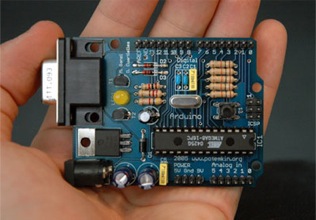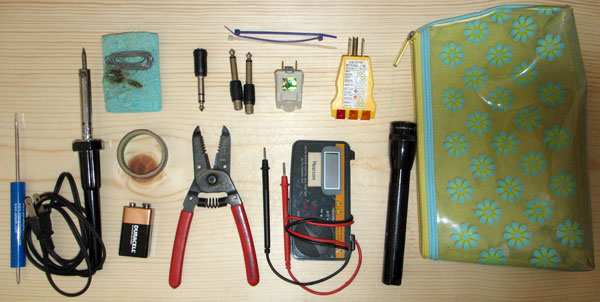
Photo by Nicholas Zambetti
I recently ordered an Arduino board to try another approach for getting sensor data into my computer. More and more of my students are using them, too, and I wanted some first-hand experience. Most of my previous work has been with the Basic Stamp family of boards. The Arduino arrived this week and I promptly sat down and gave it a try.
The first thing I noticed (aside from the price: the entire Arduino setup costs significantly less than similar boards!) was how much easier it was to get the Arduino going than the Stamp. This isn’t exactly a fair comparison, since my initial experience with Stamps was way back in 1999 or 2000, and it was also my first time fooling with microcontrollers. I’ve learned plenty since then, and the products (along with their attendant software) have come a long way. I have to give the nod to the Arduino for its cross-platform, open-source software. (When I first started with the Stamp I kept a junker 386 PC around, just to run the Stamp compiler. No fun.)
I’m also impressed by the Arduino software. I’ve admittedly done little more than fire up the example “sketches” and tweak a few lines of code. However, the Processing/Java-style language seems a better fit for my (weak) coding style. The community around the Arduino seems very active. There are already a number of projects that simplify moving data from the board to common software such as MaxMSP and Processing.
Then there’s also the luxury of the USB cable that serves for both communication and power supply. This may seem trivial, but I look forward to the day when I don’t need to change the battery in my sensor box before every performance, or carry a spare 9-volt wherever I go. I may also jettison my USB MIDI interface along with a MIDI cable required by my Stamp setup. Suddenly, though, my USB ports are getting a little crowded…
The one niggling worry I have is the serial communication with Max. Using MIDI is certainly slower, but seems foolproof to me: no handshaking necessary, a dead simple initialization process, etc. I hope my fears are simply due to a lack of experience; that once everything is setup and tested I’ll feel just as confident with the serial connection as I do with my aging MIDI cables.

